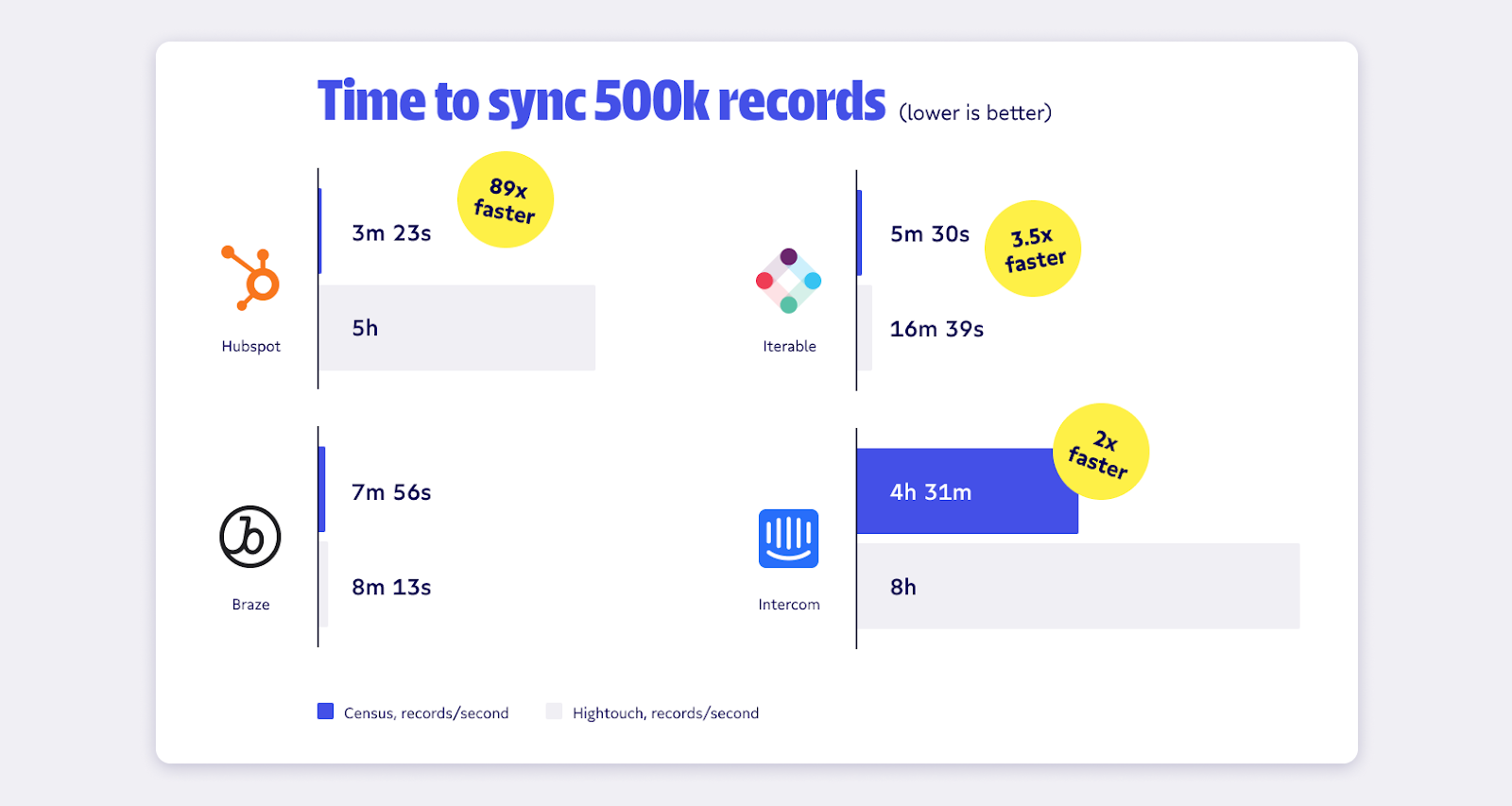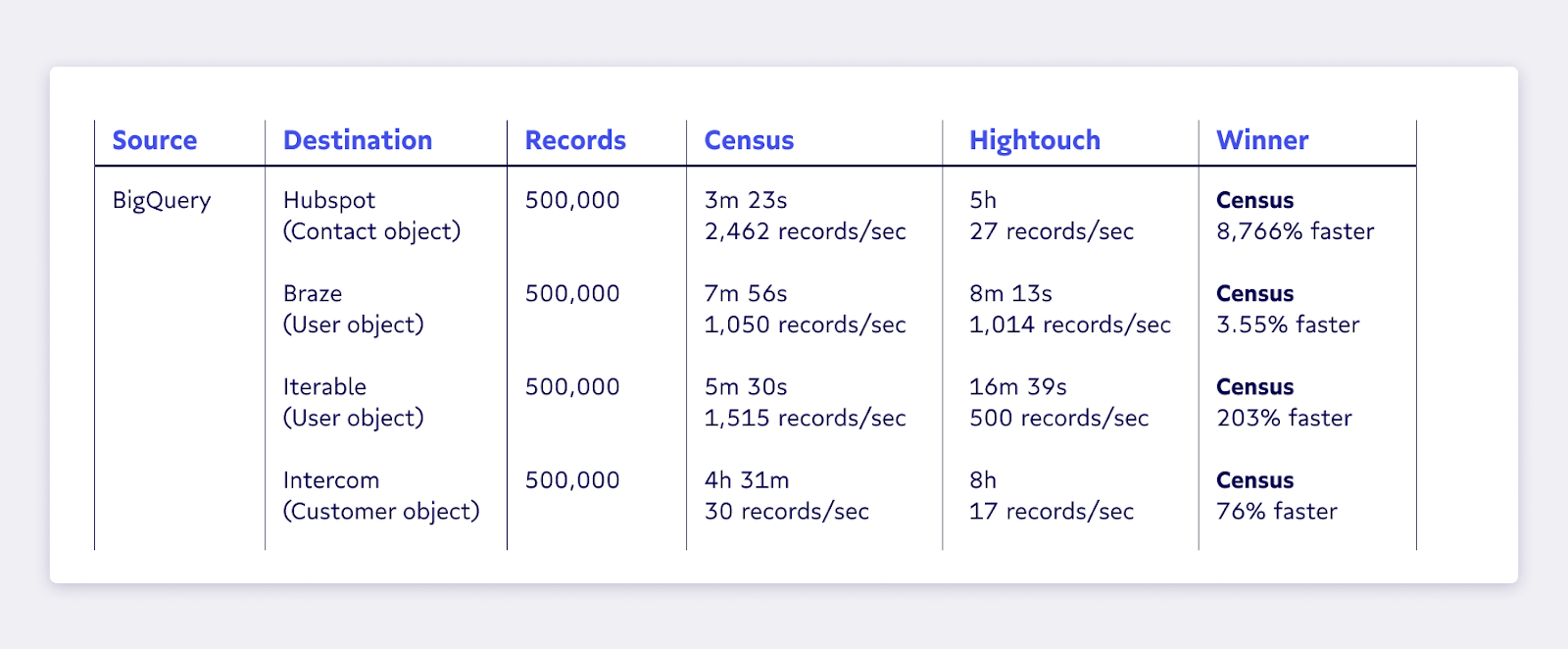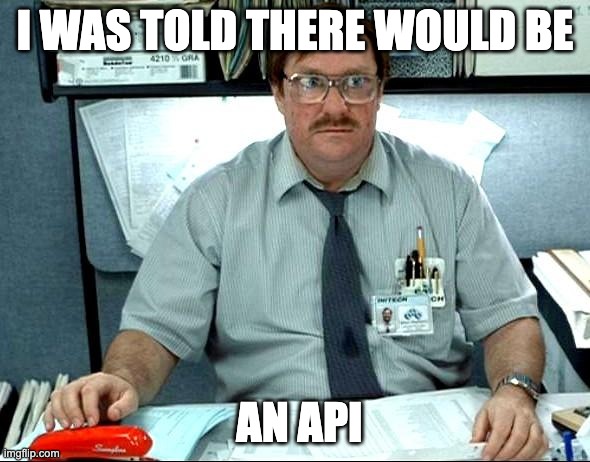In part 2 of our series on benchmarking reverse ETL tools for different use cases, we’re tackling syncing data to marketing tools. Catch part 1 here, where we stress-tested Census and Hightouch on event syncs and found that Census was a whopping 44x faster.
Want to learn why customers chose Census over Hightouch? Check out the comparison page.
Marketing is one of the core use cases for reverse ETL and when it comes to getting data into marketing tools, speed really matters. The faster you get data into your marketing tool, the faster you can reach your customer and delight them with a more personalized message.
To help you choose the reverse ETL tool that best meets your need for operational speed, we decided to benchmark reverse ETL tools for their performance in syncing to popular marketing tools--Hubspot, Intercom, Braze, and Iterable--that tackle a variety of different marketing use cases.
We’ll get into the details in the following sections, but, in our testing, we found Census was up to 88.6 times faster than Hightouch when measuring end-to-end sync speed for reverse ETL marketing syncs in Hubspot.

Let’s dive into the numbers and learn why reverse ETL performance matters, especially for marketing use cases.
Marketing use cases for reverse ETL
Fresher, richer customer data can drive better operational actions for your business, and reverse ETL is the key to unlocking it.
Here are some examples of mission-critical marketing use cases data-driven companies use reverse ETL for:
- Personalized campaigns. Build hyper-personalized marketing campaigns by merging product, support, and sales data to power customer segmentation. For example, you could target users based on who should hear about new features or an upcoming offer or automatically send the latest blog post to those most likely to read it.
- Product milestone emails. Send an email or message to a customer based on their interaction with your product. Take these common scenarios: A customer abandons their shopping cart, or someone signs up for a new trial and it kicks off an onboarding sequence. All of these are time-sensitive use cases that rely on customer data from various sources being combined like customer profile, product usage, and order history.
- Lead scoring. Segment customers based on their engagement with your company across different channels and properties. Use that segmentation to drive personalized campaigns to convert hot leads or re-engage inactive ones.
- Dynamic custom audiences. Create granular segments or audiences based on any data (e.g. product usage so you can send personalized emails or re-engage inactive users).
If you’d like to read more stories about how leading marketing teams at Canva and Notion went from good to great using Reverse ETL check out this post.
Why speed matters for marketing + reverse ETL
Let’s take a look at the descriptions for the popular marketing tools we used for this benchmark:
- Hubspot: Marketing automation and CRM solution.
- Iterable: Email marketing and marketing automation
- Braze: Customer engagement and multi-channel messaging platform.
- Intercom: Communications and messaging platform.
If we look at the common thread between these tools, you’ll notice the words “message” and “automation” appear several times. While speed matters across almost all operational efforts, it's uniquely important for communication and automation efforts. Here’s why:
- Message: Fresh data is critical for relevant personalization. The fresher the data, the more relevant the personalization. There’s nothing worse than sending a redundant offer or abandoned cart email to someone who already purchased your product, or bombarding someone with sales emails after they’re already signed up.
- Automation: Timing is everything for operations. The faster you can run operational analytics on data such as lead scoring, the faster you can act on it using automation (e.g. route the lead, trigger an alert).
TL;DR: The speed at which your customer-facing teams can get high-quality, fresh data directly impacts how well they can reach those customers with the right value add and the right time.
Census has helped us make the messaging flow a lot nicer and more targeted. We’re now able to create segments, for example is this user a hardcore Presentations user or not, and then send them emails that are part of a specific Presentations campaign. - Cuong Duong, data analyst at Canva
The benchmarking results for marketing tools
For this benchmark, we synced 500,000 customer records from Google BigQuery into Hubspot, Braze, Iterable, and Intercom using both Census and Hightouch.
As a reminder, we go deeper into the details of our testing methodology, as well as include the dataset we used so you can do your own benchmark testing, in part 1 of this series.

Numbers are awesome, but it’s the insights from these figures that tell us where each reverse ETL tool excels (and where we can challenge ourselves to build a better product).
First, Hubspot. From day one, we’ve built Census with the goal of helping users get the most of their tools (and, by proxy, their tools’ APIs), and this is true of our HubSpot connector. This dedication to helping you not just get data from A to B, but get data to its end destination efficiently, allows near-real-time use cases compared to other reverse ETL tools. Additionally, Census supports all core objects for Hubspot and custom objects, too.
Next up, Iterable. Once again, our work to help you get the most mileage out of our plans and with the other tools in your stack has resulted in an integration that makes the most of the high rate limit Iterable offers. This means you can easily send timely emails based on events (objects we support, too!) that use the Catalog object. Fun fact: We’re the only reverse ETL tool on the market that currently supports Catalog objects.
Third, Braze: As we said, there are always areas for improvement and further innovation. Both solutions perform about the same on Braze due to API rate limitations. An increase in this limit would help us see which reverse ETL tool can get the most mileage out of that higher limit. (Hint: We’re confident that when the time comes for a higher limit, Census will be able to get the furthest, fastest 😉).
Finally, Intercom. Honestly, we wouldn’t recommend using Intercom for high volumes of data because of Intercom’s low API rate limit (16/second). Additionally, they don’t currently offer a way to look up records, which means upsert syncs cost two requests, further slowing sync speed. While Census is still nearly 2x faster than our direct competition, the API implementation of Intercom results in slower-than-desired speeds.
While the above benchmarks for the marketing tools your business relies on every day are promising, there’s always room for improvement. We’re not just aiming to get the fastest sync speeds today, but actively working toward keeping up with all future improvements among destination tools to ensure your data capabilities only get better with time.
Good destination APIs are still important
Even though we’re committed to pushing the limits of reverse ETL speed, there are some cases where the quality of the destination APIs will limit how quickly you can use your data. In the case of the Intercom sync above, you can see that although Census is 2x faster, both reverse ETL tools are overall relatively slow in updating the same volume of data compared to other destinations.
What does this mean? In short: The quality of downstream destinations APIs is still important for any reverse ETL use case.
At Census, we’ve architected and tuned our reverse ETL engine to generate the maximum performance, and these results demonstrate it has a real effect. We’ve pushed the advertised service rate limits, and in some cases created high-performance workarounds, to support use cases not currently supported by downstream APIs (e.g. update only sync behavior for some objects).
But ultimately the design of SaaS destination APIs constrains all reverse ETL tools.
This greater focus on destination API quality doesn’t just make the job of our engineers more interesting, but it also creates a forcing function to push SaaS companies to improve their products in the process.
Ultimately, there’s not much point to an API if you can’t update the tool to take timely action. That’s why we’re excited to continue to partner with these SaaS tools to advocate for good, high-performant APIs. Both for the good of the data community and to unlock more and more real-time operational analytics use cases.

What’s next in our benchmarking series
That’s a wrap on part two of our benchmarking series on reverse ETL. In our upcoming posts, we’ll cover CRMs and also take a deep dive into some of the secrets behind the speed of our reverse ETL tool.
If you have any questions or suggestions on how we can make this and future benchmarks useful to you, feel free to reach out and say hi at hello@getcensus.com.
Check out part 1 of our reverse ETL benchmarking series where we looked at event syncs as well as explained our methodology and goals behind this testing. Or, if you want to get your hands on Census yourself, sign up for a demo.

















